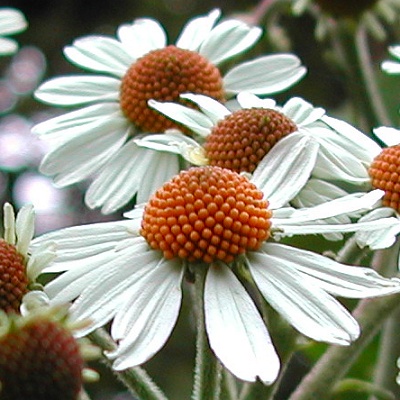Giant Tree Daisy
Germinating the seeds
When to plant -- Plant them when you receive them for best results. Getting started -- You may plant
them in small containers with drainage holes,
such as seedling starter trays Use well-draining soil. I use a mix of 1 part
coir fiber Fill the pots with your soil and sprinkle 2
to 4 seeds on top. If you have
long-fibered sphagnum moss Then add water until everything is evenly moist (but not soggy). Until they sprout, ensure that the soil surface never dries out. An easy way to maintain high moisture by enclosing the pots in a plastic container or bag - just leave it open a crack to let in fresh air. You may need to drip a few drops of water on the surface each day to keep it moist. They sprout well between about 65 to 77° F
(18-25°C). I have no knowledge about how they will germinate outside that
temperature range. I recommend placing a
minimum/maximum thermometer Keep them in bright light out of direct sun. A bright LED or fluorescent bulb kept 4 inches (10 cm) away provides the right amount of light (See: "Growing indoors with LED lights"). They tend to begin sprouting within 4 weeks, but may take longer to start. Continue giving bright, filtered light once they sprout. Fertilizing -- The first
8 weeks, feed every 7 days with a small amount of dilute (1/8 strength) liquid fertilizer.
Hydroponic fertilizer
is ideal for this, because it is easily absorbed and contains all essential
nutrients. After 8 weeks, you may switch to a granular fertilizer Watering: Once the seedlings are 3 weeks old, you may allow the surface soil to dry out, but aim to keep the rest of the soil evenly moist most of the time. Never let it dry out completely, but also don't keep it constantly soggy. Repotting -- When they are at least 3 inches tall (7 cm), you may repot them to larger containers about 1 quart (1 liter) in size. Repot gently to avoid disturbing the roots. Repot again after 4 to 6 months.. or plant in the ground in suitable areas. If you want to keep it in a pot, the final pot size depends on how large you choose to let it grow. You may prune your plant to any size that is convenient. Growing onward.. Climate -- It comes from mountainous areas where the temperature is mild and nights are cool. This species seems more tolerant of heat than typical cloud forest plants. It has handled temperatures in the upper 80s to low 90s (33°C). It is certainly worth a try in warmer areas like Florida, although it's possible that it won't bloom due to the heat. If your plant appears stressed from heat, shade it from sun and keep it moist. Frost will damage the foliage, but the plant can probably take at least several degrees of frost (-3°C), with new growth emerging from the base. Still, i recommend protecting it from frost. It might not thrive in very dry air - over about 40% humidity is best. If your plants seem to suffer from low humidity indoors, consider using an ultrasonic humidifier. Lighting -- Older plants prefer filtered sunlight or morning sun, with some protection from strong afternoon sun, which may wilt the leaves. The leaves seem to grow the largest in shade. If you have any questions or problems, please contact me. Have fun growing them! - Jeff Strange Wonderful Things
|
|||||||||


